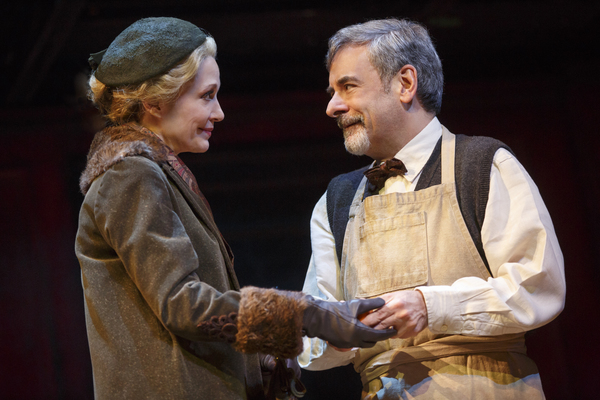
Almost a year has passed since the Broadway closing of the incredibly successful revival of Cabaret, produced by the Roundabout Theater Company. This national tour brings the Broadway production to Milwaukee, among numerous other stops on its lengthy tour. The show is a not-to-be-missed spectacle. It’s decadent, splashy, naughty, heart-wrenching and joyful, as residents of 1931 Berlin party away while the Nazis rise in power. The Roundabout version knocks this concept out of the ballpark. It hits all the right notes to create a show that is simultaneously thrilling and chilling. As in the original, the boisterous scenes in the sleazy Kit Kat Club alternate with dialogue in the rooming house of Fraulein Schneider. Here, she is played by a tall, stately Shannon Cochran. Her ramrod-straight posture is in marked contrast to all the bending Fraulein Schneider has had to do over the years, as various political parties, recession and scarcity have come and gone (beautifully illustrated in the song, “What Would You Do?”) Like the rest of her community, Fraulein Schneider is confident that the Nazi scare will pass. This notion is echoed by Fraulein’s suitor, the sweet, gentlemanly Herr Schultz (another top-notch performance by Mark Nelson). Only a strong reprimand from Ernst (Ned Noyes), an old friend and Nazi sympathizer, opens Fraulein Schneider’s eyes to the possible dangers of marrying a Jew. She breaks off their engagement. This is a small subplot to the main story, but the revival’s creators have invested it with all the respect it deserves. It is an excellent counterpoint to another relationship between two much younger people. There is Cliff, an American writer (Lee Aaron Rosen) who is intoxicated by Sally, a 19-year-old chanteuse at the Kit Kat Club (Andres Goss). Physically, Rosen’s large frame suggests a sanctuary for the waif-like Sally. Somehow, Cliff finds himself agreeing to Sally’s suggestion that she would be an ideal roommate for him. For those who’ve viewed older versions of Cabaret, either onstage or via the 1972 film starring Joel Grey as the Emcee and Liza Minnelli as Sally, this revival is far more explicit. For instance, Cliff’s homosexuality is more pronounced. One gets the idea that he submits to Sally’s lust only because they must share one small bed, and what’s a guy to do? Cliff also seems more determined to “wake up” his neighbors to the growing Nazi threat. Don’t worry, they assure him. We are Germans, after all. They haven’t a clue about what is coming. Their indifference makes Cliff’s eventual departure seem even more desperate than it needs to be. He feels such a sense of dread that it’s as if he cannot find enough air to breathe. He cannot even save Sally, who decides she doesn’t want to be saved. As Sally sings the title song (instead of belting it to the rafters), it feels more authentic than it did previously. It honors the effect of stressful emotional and physical events that Sally has already endured that day. Goss has a big voice, but in this song it is softer and sadder than one recalls from Act I. (By contrast, one of Sally’s opening songs in the club, “Don’t Tell Mama,” is brilliantly delivered by an ebullient Sally with the able assistance of the Kit Kat Boys and Girls.) One of the most striking differences between the original Cabaret and this revival is the Emcee’s role. Here, he becomes an even more important player than previously. In both cases the Emcee begins by welcoming the audience to the Kit Kat Club with “Wilkommen,” one of the best opening numbers ever written. It sets the tone and the story in a way that never fails to draw the audience into the club’s decadent, anything-goes atmosphere. In the Roundabout version, the Emcee is in nearly every scene. Sometimes, he’s there to hold a prop until needed. At other times, he camouflages himself with the ease of a chameleon. Audiences are left wondering where he will turn up next. His grinning whiteface and jester-like movements are ideal for songs such as “Money” and “Two Ladies.” In the Roundabout version, one of the “ladies” is a boy dressed as a woman – again stressing the decadence of the period. “We have no troubles here,” he keeps repeating, almost defiantly. In the final scene, it becomes clear that he must pay a tremendous price for ignoring the events happening beyond the club’s walls. Randy Harrison stars as the Emcee. Much can be said about the show’s excellent costumes, which invoke the flavor of the time period as well as the slovenly characteristics of the Kit Kat singers, dancers and musicians (the entire orchestra is comprised of Kit Kat staffers). The Emcee’s outfit is brilliantly outlandish, although in truth, he wears half a dozen outfits in the show. But mention must be made of the set design. A string of large, winking light bulbs frame the stage as a sort of giant marquee. A smaller frame, slightly cockeyed, sits on a raised platform. It is here that the orchestra plays. “Downstairs” has a backdrop featuring three identical black doors. They are set into a wall that’s covered by dark-red wallpaper. It is an unsettling sight – and perfect for the events that are about to take place within the world of Cabaret.
